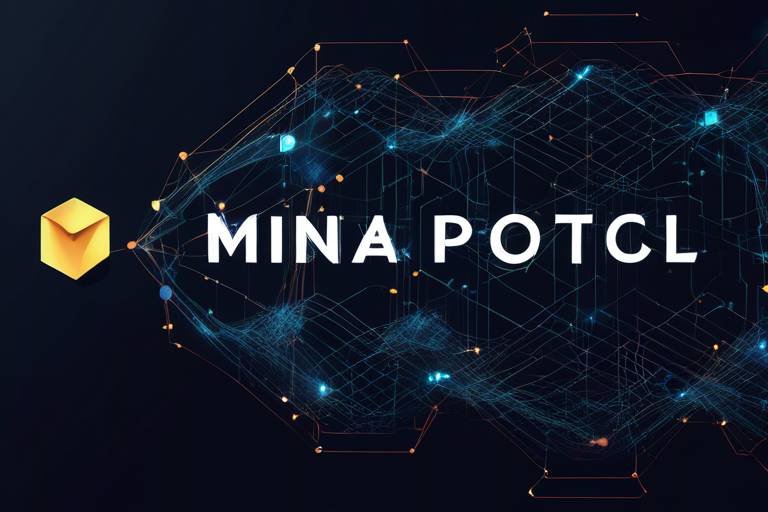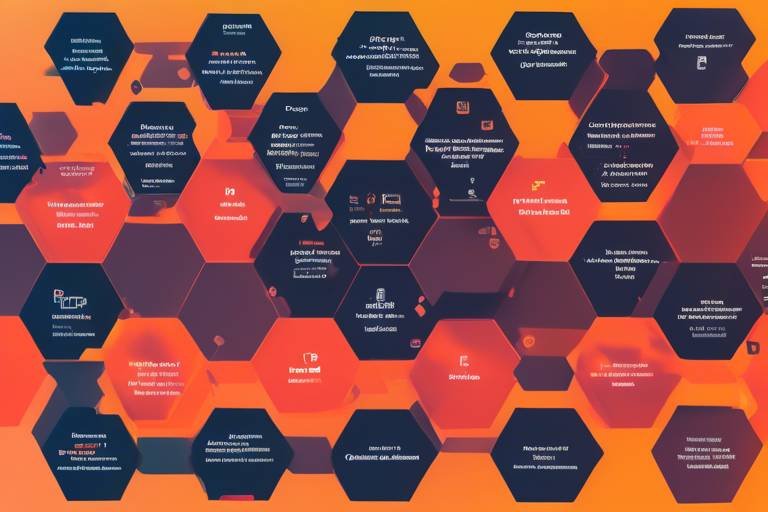Matic Network - Scaling Ethereum Solutions Explained
The Matic Network, now rebranded as Polygon, is like a superhero in the world of blockchain, swooping in to save Ethereum from its notorious scalability woes. Imagine trying to fit a huge crowd into a tiny room—this is what Ethereum has been grappling with as its popularity soared. With more users and applications, the network has faced significant challenges in processing transactions quickly and affordably. The Matic Network offers a solution by providing Layer 2 scaling solutions that enhance transaction throughput while ensuring that the pillars of security and decentralization remain intact.
So, how does Matic achieve this? The secret sauce lies in its innovative technology stack, which combines the power of Plasma and Proof of Stake mechanisms. These technologies work together like a well-oiled machine, allowing Matic to process transactions much faster than the Ethereum main chain while keeping costs low. This is crucial for developers and users alike, as it makes decentralized applications (dApps) more accessible and efficient. Picture a bustling highway with multiple lanes—Matic opens up those extra lanes, allowing for smoother traffic flow and reduced congestion on Ethereum's main road.
As we dive deeper into the workings of Matic Network, it's essential to understand the core components that make it tick. The Plasma framework is one of the key technologies that enables Matic to create child chains, which process transactions off the main Ethereum blockchain. This significantly increases transaction speeds and reduces congestion on the main chain. Think of it as a series of express lanes that can handle more vehicles at once, allowing for quicker arrivals at the destination.
However, like any good story, there are challenges to overcome. The Plasma framework, while beneficial, faces issues such as exit delays and security concerns. But fear not! Matic Network has strategies in place to address these challenges, ensuring that users can enjoy a seamless experience without compromising on security. This ongoing battle between innovation and challenges is what keeps the blockchain landscape exciting and ever-evolving.
Another vital component of the Matic Network is its Proof of Stake consensus mechanism. This allows validators to secure the network while earning rewards, creating a win-win scenario. Validators are incentivized to act honestly, which enhances the overall security and efficiency of the network. It's like having a team of dedicated lifeguards at a pool—they ensure that everything runs smoothly while also getting rewarded for their vigilance.
As we explore the various use cases of Matic Network, it becomes clear that its versatility is one of its strongest assets. From decentralized finance (DeFi) to gaming applications, Matic is making waves across multiple sectors. In the DeFi space, users benefit from lower transaction costs and faster processing times, making it an attractive platform for developers looking to build innovative financial solutions. Imagine being able to send money across the globe in seconds for a fraction of the cost—this is the reality that Matic Network is helping to create.
The gaming industry, too, is reaping the rewards of Matic's scalability. Developers are leveraging this technology to create immersive and efficient gaming experiences that were previously unattainable on the Ethereum main chain. With Matic, players can enjoy fast, seamless gameplay without the frustrating lag times that often plague traditional blockchain games. It's like upgrading from a dial-up connection to high-speed internet—once you've experienced the difference, there's no going back!
Looking ahead, the future of Matic Network is bright. As the blockchain landscape continues to evolve, Matic is committed to innovation and improvement. Speculations abound regarding future developments and the potential impact of Matic on the broader Ethereum ecosystem. With its focus on scalability and user experience, Matic Network is well-positioned to play a pivotal role in the ongoing evolution of decentralized technology.
- What is Matic Network? Matic Network, now known as Polygon, is a Layer 2 scaling solution for Ethereum that enhances transaction speeds and reduces costs.
- How does Matic Network improve Ethereum's scalability? Matic uses technologies like Plasma and Proof of Stake to process transactions off the main Ethereum blockchain, increasing throughput and efficiency.
- What are the main benefits of using Matic Network? Users benefit from faster transactions, lower fees, and improved user experience for decentralized applications.
- What challenges does Matic Network face? Challenges include exit delays and security concerns associated with the Plasma framework, which Matic is actively addressing.
- What industries can benefit from Matic Network? Matic is versatile and supports various industries, including decentralized finance (DeFi) and gaming.

Introduction to Matic Network
Matic Network, now rebranded as Polygon, was born out of necessity in the ever-evolving world of blockchain technology. As Ethereum's popularity skyrocketed, so did its scalability issues. Imagine trying to squeeze a river through a garden hose; that's Ethereum under heavy traffic. Polygon steps in as a superhero, offering a Layer 2 solution that not only enhances transaction throughput but also maintains the core principles of security and decentralization that Ethereum is built upon.
At its core, Polygon aims to create a multi-chain ecosystem that is both user-friendly and efficient. By employing a range of innovative technologies, it allows developers to build robust decentralized applications (dApps) that can handle a massive influx of users without breaking a sweat. This means that whether you're trading NFTs, engaging in DeFi, or playing blockchain-based games, the experience remains seamless and cost-effective.
One of the standout features of Polygon is its ability to scale Ethereum without compromising on security. It achieves this by utilizing a combination of techniques that include Plasma and Proof of Stake mechanisms, which we will delve into in the subsequent sections. With Polygon, the possibilities are endless, and its growing adoption across various sectors showcases its potential to reshape the blockchain landscape.
In a nutshell, Polygon is not just a solution; it's a revolution in how we think about scaling Ethereum. By addressing the pressing issues of speed and cost, it opens up a world of opportunities for developers and users alike. So, whether you're a seasoned crypto enthusiast or a curious newcomer, understanding Polygon's role in the Ethereum ecosystem is essential for navigating the future of decentralized technology.

How Matic Network Works
The Matic Network, now rebranded as Polygon, employs a unique blend of technologies to tackle the notorious scalability issues that have plagued Ethereum. By leveraging a combination of Plasma and Proof of Stake mechanisms, Matic is able to enhance transaction throughput significantly while ensuring that security and decentralization remain intact. Imagine a bustling highway where traffic is constantly jammed; Matic serves as the express lanes that allow vehicles to zoom past congestion, making the journey smoother and faster for everyone involved.
At the core of Matic's functionality is the Plasma Framework, which allows the network to create child chains that operate off the main Ethereum blockchain. This means that transactions can be processed more quickly and efficiently, reducing the burden on Ethereum's main chain. Think of it like having a dedicated express train that runs parallel to a crowded commuter line, allowing passengers to reach their destinations without the usual delays. By offloading transactions to these child chains, Matic can handle thousands of transactions per second, a feat that is crucial for the growing demand in the blockchain ecosystem.
The Plasma framework is a game-changer for Matic Network. It facilitates the creation of child chains, which are essentially smaller blockchains that can process transactions independently while still being anchored to the main Ethereum chain. This setup not only increases transaction speeds but also minimizes congestion on the Ethereum network. With Plasma, users can enjoy a more seamless experience, whether they're trading cryptocurrencies, engaging in decentralized finance (DeFi), or playing blockchain-based games.
One of the standout benefits of the Plasma framework is its ability to provide enhanced scalability. By enabling off-chain transactions, Matic can significantly lower fees, making it more accessible for users. Here are some key advantages:
- Lower Transaction Costs: Users can enjoy significantly reduced fees compared to Ethereum's main chain.
- Faster Transaction Speeds: Transactions are processed off-chain, allowing for near-instant confirmations.
- Improved User Experience: Developers can build applications that are more responsive and user-friendly.
However, it's not all smooth sailing with Plasma. There are challenges that need to be addressed, such as exit delays and security concerns. When users want to exit from a child chain back to the main Ethereum chain, they may face delays, which can be frustrating. Additionally, ensuring the security of off-chain transactions is paramount. Matic Network has been proactive in tackling these issues by implementing robust security measures and improving the user experience during exit processes.
Another crucial aspect of how Matic Network operates is its Proof of Stake (PoS) consensus mechanism. Unlike traditional mining, where energy-intensive computations are used to validate transactions, PoS allows validators to secure the network by staking their tokens. This not only makes the network more efficient but also environmentally friendly. Validators earn rewards for their contributions, creating an incentive to maintain the network's integrity. This mechanism ensures that Matic can process transactions quickly while keeping security at the forefront.
In summary, Matic Network stands out in the blockchain landscape by combining advanced technologies like Plasma and Proof of Stake. This innovative approach allows it to offer a scalable, efficient, and secure environment for decentralized applications. Whether you're a developer looking to build the next big thing or a user wanting a smoother transaction experience, Matic Network is paving the way for a more accessible blockchain future.
Q: What is Matic Network?
A: Matic Network, now known as Polygon, is a Layer 2 scaling solution for Ethereum that enhances transaction speeds and reduces costs for decentralized applications.
Q: How does Plasma work?
A: Plasma allows Matic to create child chains that process transactions off the main Ethereum blockchain, significantly increasing transaction speeds and reducing congestion.
Q: What are the benefits of using Matic Network?
A: The benefits include lower transaction costs, faster processing times, and improved user experiences for decentralized applications.
Q: What challenges does Matic Network face?
A: Challenges include exit delays when moving funds back to the Ethereum main chain and ensuring security for off-chain transactions.
Q: What is the Proof of Stake mechanism?
A: Proof of Stake is a consensus mechanism that allows validators to secure the network by staking their tokens, earning rewards while maintaining efficiency and security.

Plasma Framework
The is a groundbreaking technology that plays a pivotal role in the operation of the Matic Network (now known as Polygon). It allows the creation of child chains that can process transactions independently from the main Ethereum blockchain. Imagine the main Ethereum chain as a busy highway, often congested with traffic, where every vehicle represents a transaction. By utilizing Plasma, Matic essentially builds side roads that can handle their own traffic, significantly alleviating congestion and enhancing overall speed.
One of the key advantages of Plasma is its ability to enable off-chain transactions. This means that transactions can be processed on these child chains without needing to interact with the main Ethereum chain for every single operation. As a result, users experience faster transaction times and lower fees, making decentralized applications (dApps) much more efficient and accessible. For instance, consider a bustling marketplace where buyers and sellers can make quick deals without waiting in line. That’s the kind of efficiency Plasma brings to the blockchain world.
To better understand how Plasma enhances scalability, let’s take a look at the following table, which illustrates the differences between on-chain and off-chain transactions:
| Feature | On-Chain Transactions | Off-Chain Transactions (via Plasma) |
|---|---|---|
| Transaction Speed | Slower due to network congestion | Faster, as they are processed on child chains |
| Transaction Fees | Higher fees due to gas costs | Lower fees, making it more economical |
| Security | Secured by Ethereum's main chain | Secured through a combination of child chains and main chain |
However, while the Plasma framework offers remarkable benefits, it is not without its challenges. One of the primary concerns is the exit delays that can occur when users wish to move their assets back to the main Ethereum chain. This process can sometimes take longer than expected, leading to frustration among users. Additionally, there are security concerns regarding the integrity of the child chains. If a child chain were to be compromised, it could put user funds at risk.
Fortunately, Matic Network has implemented various strategies to mitigate these challenges. They have designed mechanisms to ensure that users can exit the Plasma chain securely and efficiently, while also enhancing the security protocols of the child chains. This proactive approach helps to foster trust and reliability within the ecosystem, enabling developers and users alike to leverage the full potential of the Plasma framework.
In summary, the Plasma framework is a cornerstone of the Matic Network's ability to scale Ethereum effectively. By facilitating off-chain transactions and alleviating congestion on the main chain, it not only enhances user experience but also paves the way for a more robust and efficient blockchain ecosystem. As we continue to explore the capabilities of Matic, it’s clear that Plasma will remain a vital component in the quest for scalable and accessible decentralized applications.

Benefits of Plasma
The Plasma framework is a game-changer for the Matic Network, offering a multitude of benefits that make it an attractive option for developers and users alike. One of the most significant advantages is its ability to enhance scalability. By processing transactions off the main Ethereum blockchain, Plasma alleviates the congestion that often plagues the main chain, allowing for a smoother and faster user experience. Imagine trying to navigate a busy highway during rush hour; it’s frustrating and slow. Now, think of Plasma as a series of express lanes that let you zip through traffic without the usual delays.
Another remarkable benefit of Plasma is the reduction in transaction fees. In the world of blockchain, high fees can deter users from engaging fully with decentralized applications (dApps). With Plasma, off-chain transactions incur significantly lower costs, making it more feasible for users to interact with these applications regularly. This is particularly vital for microtransactions, which can become impractical if fees are too high. By lowering costs, Plasma opens the door for a broader audience to participate in the decentralized economy.
Moreover, Plasma enhances the overall user experience by enabling faster transaction confirmations. Users no longer have to wait for long periods to see their transactions completed. Instead, they can enjoy near-instant confirmations, which is especially crucial for applications that require real-time interactions, such as gaming or trading platforms. This speed not only improves user satisfaction but also encourages more frequent use of dApps, thus driving further adoption.
In addition to these benefits, Plasma also contributes to improved security. Although transactions are processed off-chain, they still retain a connection to the main Ethereum chain, ensuring that the security principles of Ethereum are upheld. This means that while users enjoy the benefits of speed and lower costs, they can also have peace of mind knowing that their transactions are secure.
To summarize, the benefits of Plasma in the Matic Network can be encapsulated as follows:
- Enhanced Scalability: Reduces congestion on the main Ethereum blockchain.
- Lower Transaction Fees: Makes decentralized applications more accessible.
- Faster Transaction Confirmations: Provides a seamless user experience.
- Improved Security: Maintains Ethereum's robust security features.
These advantages make Plasma a pivotal component of the Matic Network, transforming the way users interact with blockchain technology. As the ecosystem continues to evolve, the role of Plasma will likely become even more critical in shaping the future of decentralized applications.

Challenges of Plasma
While the Plasma framework offers significant advantages for scaling Ethereum, it is not without its challenges. One of the primary issues is the concept of exit delays. When users want to withdraw their funds back to the Ethereum main chain, they may face long wait times. This delay occurs because the system needs to ensure that the transactions are secure and that no fraudulent activities have taken place. Imagine waiting for a bus that you know is coming but can’t see yet; that’s how users might feel when they initiate an exit.
Another challenge is security concerns. Although Plasma is designed to enhance security through its architecture, it can still be vulnerable to certain types of attacks, especially during the exit process. For instance, if a malicious actor attempts to manipulate the child chain, it could jeopardize the funds of users who are trying to exit. This is akin to a bank heist where the robbers know they can only get away with the money if they can outsmart the security system.
Moreover, the complexity of the Plasma framework can be daunting for developers. Building applications that effectively utilize Plasma requires a deeper understanding of the underlying mechanics, which can be a barrier to entry for many. This complexity can lead to potential bugs and inefficiencies, creating a less than optimal user experience. In the fast-paced world of blockchain, where users expect seamless interactions, any hiccup can lead to frustration.
Despite these challenges, the Matic Network is constantly working to address these issues. For example, they are implementing solutions to minimize exit delays and enhance security protocols. The goal is to create a more robust ecosystem that not only supports scalability but also ensures that users feel safe and confident in their transactions. As Matic continues to evolve, it’s essential to keep an eye on how they tackle these challenges to maintain their position as a leader in the Layer 2 solutions space.
- What is Plasma? Plasma is a framework that allows for the creation of child chains, enabling faster transactions by processing them off the main Ethereum blockchain.
- What are exit delays? Exit delays refer to the time it takes for users to withdraw their funds from the Plasma network back to the Ethereum main chain, which can vary based on security checks.
- How does Matic Network address security concerns? Matic Network employs various security measures, including enhanced protocols and monitoring systems, to safeguard users' funds and transactions.
- Can developers easily build on Plasma? While Plasma offers great scalability, it requires a solid understanding of its mechanics, which can be challenging for some developers.

Proof of Stake Mechanism
The Proof of Stake (PoS) mechanism is a game-changer for the Matic Network, enhancing its efficiency and security. Unlike the traditional Proof of Work (PoW) model, where miners compete to solve complex mathematical problems, PoS allows validators to create new blocks and verify transactions based on the number of tokens they hold and are willing to "stake" as collateral. This significantly reduces the energy consumption associated with blockchain operations, making Matic not only faster but also more environmentally friendly.
In the Matic Network, validators are incentivized to maintain the integrity of the network. When they stake their tokens, they are essentially betting on the network’s success. If they act maliciously or fail to validate transactions properly, they risk losing their staked tokens. This creates a robust security layer that discourages dishonest behavior and encourages validators to act in the best interest of the network.
Here’s how the PoS mechanism contributes to Matic's overall efficiency:
- Lower Transaction Costs: By eliminating the need for energy-intensive mining, transaction fees on the Matic Network are significantly reduced, making it more attractive for users and developers alike.
- Faster Transaction Confirmation: Validators can confirm transactions quickly since they are chosen based on the amount of cryptocurrency staked rather than their computational power. This leads to rapid transaction processing.
- Enhanced Security: The risk of losing staked tokens acts as a deterrent against malicious activities, ensuring a more secure environment for decentralized applications.
Moreover, Matic’s PoS mechanism is designed to be highly scalable. As more users join the network and more validators participate, the system can accommodate increased transaction loads without compromising speed or security. This scalability is crucial for the future growth of decentralized applications on the Matic Network.
In summary, the Proof of Stake mechanism is pivotal for Matic Network's operation, balancing the need for speed, security, and sustainability. As the blockchain landscape continues to evolve, Matic's innovative approach to consensus will likely inspire other networks to adopt similar models, further pushing the boundaries of what decentralized technologies can achieve.
- What is Proof of Stake? Proof of Stake is a consensus mechanism that allows validators to create new blocks and verify transactions based on the amount of cryptocurrency they hold and stake as collateral.
- How does PoS enhance security? Validators risk losing their staked tokens if they act maliciously, which discourages dishonest behavior and promotes network integrity.
- Are transaction fees lower on Matic Network? Yes, the PoS mechanism significantly reduces transaction fees compared to traditional mining-based networks.
- Can Matic Network scale with more users? Absolutely! Matic's PoS system is designed to scale efficiently, accommodating increased transaction loads without sacrificing performance.

Use Cases of Matic Network
The Matic Network, now rebranded as Polygon, has emerged as a game-changer in the blockchain ecosystem, particularly in the realms of decentralized applications (dApps). Its robust architecture allows developers to create solutions that are not only efficient but also cost-effective. Let's dive into some of the most exciting use cases of Matic Network that showcase its versatility and potential.
One of the most significant areas where Matic Network shines is in Decentralized Finance (DeFi). With the rise of DeFi, users are seeking platforms that can offer lower transaction costs and faster processing times. Matic Network has become a popular choice among DeFi projects due to its ability to handle a high volume of transactions without the congestion that often plagues the Ethereum mainnet. Notable DeFi applications built on Matic include Aave and Curve Finance, which have successfully leveraged Matic’s capabilities to enhance user experience while minimizing fees.
Another exciting domain is the Gaming Industry. Matic Network provides the scalability needed for developers to create immersive gaming experiences that can handle thousands of players simultaneously. Traditional gaming platforms often face issues like lag and high transaction fees, but with Matic, developers can create games that are not only engaging but also financially viable. Games like My Neighbor Alice and CryptoBlades are already utilizing Matic’s infrastructure to deliver seamless gameplay and quick transactions, making them more appealing to users.
Moreover, Matic Network supports various Non-Fungible Tokens (NFTs), which have taken the digital art world by storm. The ability to mint and trade NFTs on a platform that offers lower fees and faster transactions has made Matic a go-to solution for artists and collectors alike. Platforms like OpenSea and Rarible are integrating with Matic to provide users with a more efficient way to buy, sell, and trade NFTs without the hefty gas fees associated with Ethereum.
In addition to these sectors, Matic Network is also making strides in the realm of Supply Chain Management. By providing a transparent and immutable ledger, Matic enables businesses to track their products from origin to consumer seamlessly. This not only enhances trust among stakeholders but also increases operational efficiency. Companies are beginning to realize that integrating Matic into their supply chain processes can lead to significant cost savings and improved accountability.
To summarize, Matic Network is not just a solution to Ethereum's scalability issues; it is a versatile platform that supports a myriad of applications across different industries. From DeFi to gaming and NFTs to supply chain management, Matic is paving the way for a more efficient and accessible blockchain ecosystem.
- What is Matic Network?
Matic Network, now known as Polygon, is a Layer 2 scaling solution for Ethereum that improves transaction speeds and reduces costs.
- How does Matic Network enhance DeFi applications?
Matic Network allows DeFi applications to operate with lower fees and faster transaction times, making them more user-friendly.
- Can Matic Network support gaming applications?
Yes, Matic Network provides the necessary scalability for developers to create engaging and efficient gaming experiences.
- What advantages does Matic offer for NFT transactions?
Matic offers lower transaction fees and faster processing times, making it an ideal platform for minting and trading NFTs.
- How does Matic Network improve supply chain management?
Matic provides a transparent and immutable ledger that enhances tracking and accountability in supply chain processes.

Decentralized Finance (DeFi)
Decentralized Finance, or DeFi, is revolutionizing the way we think about finance, and Matic Network is at the forefront of this transformation. Imagine a world where you can lend, borrow, and trade assets without the need for traditional banks or financial institutions. That's the beauty of DeFi, and Matic makes it all possible by providing a scalable and efficient platform for these applications.
One of the main advantages of using Matic Network for DeFi projects is the significant reduction in transaction costs. In the traditional Ethereum network, high gas fees can make small transactions impractical. However, with Matic's Layer 2 solution, users can enjoy drastically lower fees, making it feasible to engage in microtransactions. This is particularly beneficial for users who want to participate in lending platforms or liquidity pools where every penny counts.
Moreover, Matic Network's ability to process transactions quickly enhances the overall user experience. In a world where speed is everything, waiting for transactions to confirm can be frustrating. With Matic, users can execute trades and transfers almost instantaneously, allowing for a seamless interaction with various DeFi protocols. This speed is crucial, especially in volatile markets where every second can mean a significant difference in profit or loss.
Here are some notable DeFi applications that have successfully integrated with Matic Network:
- Aave: A popular lending protocol that allows users to earn interest on deposits and borrow assets.
- SushiSwap: A decentralized exchange that provides liquidity and allows users to trade various tokens.
- Curve Finance: A platform specifically designed for stablecoin trading, offering low slippage and low fees.
These applications demonstrate the versatility and potential of Matic Network in the DeFi space. By lowering barriers to entry, Matic is making it easier for users to access financial services that were once limited to a select few. This democratization of finance is not just a trend; it's a movement towards a more inclusive financial ecosystem.
In conclusion, Matic Network is not just a scaling solution; it’s a catalyst for the DeFi revolution. By enhancing transaction speeds and reducing costs, it empowers users to take control of their financial destinies. As more DeFi projects continue to emerge on the Matic platform, we can expect to see a flourishing ecosystem that benefits everyone involved.
What is DeFi?
DeFi, or Decentralized Finance, refers to financial services that are built on blockchain technology, allowing users to conduct transactions without intermediaries.
How does Matic Network enhance DeFi?
Matic Network provides lower transaction fees and faster processing times, making it an ideal platform for DeFi applications.
Are there any risks associated with DeFi?
Yes, while DeFi offers many benefits, it also comes with risks such as smart contract vulnerabilities and market volatility.

Gaming Applications
The gaming industry has always been at the forefront of technological innovation, and with the advent of blockchain technology, it has found a new playground. Matic Network, now Polygon, is revolutionizing the gaming experience by offering a robust platform that combines speed, efficiency, and lower transaction costs. Imagine playing your favorite game without the annoying lag or high fees that often plague traditional gaming platforms. With Matic, developers can create immersive environments that keep players engaged without the frustration of slow transactions.
One of the standout features of Matic Network is its ability to handle a large number of transactions per second, which is crucial for online gaming. Games that involve real-time interactions, such as multiplayer online battle arenas (MOBAs) or massively multiplayer online games (MMOs), can benefit immensely from Matic's Layer 2 solutions. The seamless integration of blockchain technology allows players to own in-game assets securely, trade them without intermediaries, and enjoy a decentralized gaming experience.
Moreover, the Matic Network supports the creation of non-fungible tokens (NFTs), which have become a game-changer in the gaming world. Players can truly own their unique in-game items, skins, or characters, and trade them on various marketplaces. This ownership is not just a gimmick; it adds real value to the gaming experience. For instance, players can earn money by selling rare items or characters they’ve acquired over time, turning their passion into profit.
To illustrate the potential of Matic in gaming, let’s consider a few successful projects that have already made waves:
- Axie Infinity: A blockchain-based game where players breed, battle, and trade fantasy creatures known as Axies. The game has seen explosive growth, thanks in part to Matic's fast transactions and low fees.
- Decentraland: A virtual reality platform powered by the Ethereum blockchain, where users can create, experience, and monetize content and applications. Matic enhances the user experience by providing faster transactions for buying and selling virtual land.
- CryptoKitties: One of the first blockchain games to gain popularity, allowing players to breed and trade virtual cats. Matic helps in reducing congestion during peak times, ensuring that transactions happen smoothly.
These examples showcase the versatility of Matic Network in the gaming sector. By reducing transaction times and costs, developers can focus more on creating engaging content rather than worrying about blockchain limitations. The future looks bright for gaming on Matic, as more developers are likely to embrace this technology to enhance their games and provide players with an unparalleled experience.
As we move forward, it’s clear that Matic Network is not just a solution for Ethereum's scalability issues but is also paving the way for a new era in gaming. With the potential for creating decentralized economies within games and the ability for players to truly own their assets, Matic is set to redefine what gaming can be in the blockchain era.
Q1: What is Matic Network?
A1: Matic Network, now known as Polygon, is a Layer 2 scaling solution for Ethereum that enhances transaction speeds and reduces costs, making it easier for decentralized applications to operate efficiently.
Q2: How does Matic improve gaming experiences?
A2: Matic improves gaming experiences by providing high transaction speeds and low fees, allowing for real-time interactions and secure ownership of in-game assets through blockchain technology.
Q3: Can I trade in-game items on Matic?
A3: Yes! Matic supports the creation of non-fungible tokens (NFTs), enabling players to own and trade unique in-game items securely and efficiently.
Q4: What types of games are built on Matic Network?
A4: Matic Network supports various types of games, including multiplayer online games, virtual reality experiences, and NFT-based games, enhancing their functionality and user experience.

Future of Matic Network
The future of the Matic Network, now widely recognized as Polygon, looks incredibly promising as it continues to innovate and adapt to the ever-evolving landscape of blockchain technology. With Ethereum's ongoing challenges related to scalability, transaction costs, and network congestion, Polygon stands out as a beacon of hope for developers and users alike. As the demand for decentralized applications (dApps) grows, so does the necessity for solutions that not only enhance performance but also maintain the core principles of decentralization and security.
One of the key aspects driving the future of Polygon is its commitment to interoperability. As the blockchain ecosystem expands, the ability for different networks to communicate and operate seamlessly together becomes crucial. Polygon is actively working on bridging various blockchain networks, allowing developers to build applications that can leverage the strengths of multiple chains. This could lead to a more connected and efficient blockchain environment, where assets and data flow freely between platforms.
Moreover, the rise of Layer 2 solutions is another area where Polygon is set to shine. As more projects look for ways to scale effectively, Layer 2 solutions offer a viable path forward. Polygon's architecture is designed to support a multitude of Layer 2 protocols, which means it can cater to a diverse range of applications—from gaming to finance—while ensuring low fees and high transaction speeds. This adaptability not only enhances the user experience but also attracts more developers to the platform, creating a self-reinforcing cycle of growth and innovation.
Furthermore, the integration of zero-knowledge rollups is on the horizon for Polygon. This technology promises to significantly improve transaction privacy and efficiency, making it an attractive option for businesses that prioritize data security. As privacy becomes increasingly important in the digital age, Polygon's advancements in this area could set it apart from other blockchain networks, ensuring its relevance and utility in the future.
To illustrate the potential developments, consider the following table that outlines some anticipated features and innovations for Polygon:
| Feature | Description | Expected Impact |
|---|---|---|
| Interoperability | Seamless communication between multiple blockchains. | Enhanced ecosystem connectivity. |
| Layer 2 Solutions | Support for various scaling solutions to improve performance. | Lower fees and faster transactions. |
| Zero-Knowledge Rollups | Improved transaction privacy and efficiency. | Greater data security for users. |
In addition to technological advancements, the community surrounding Polygon is also a vital component of its future. With a vibrant ecosystem of developers, investors, and users, Polygon is poised to foster innovation from the ground up. The platform encourages community engagement through initiatives like hackathons and grants, which not only stimulate creativity but also help in identifying real-world problems that can be solved using blockchain technology.
In conclusion, the future of the Matic Network, or Polygon, is bright and full of potential. As it continues to push the boundaries of what is possible in the blockchain space, we can expect to see a surge in adoption and application development. By prioritizing interoperability, Layer 2 solutions, and user privacy, Polygon is not just keeping pace with the evolving landscape; it is leading the charge into a new era of decentralized technology.
- What is Matic Network? - Matic Network, now known as Polygon, is a Layer 2 scaling solution for Ethereum that enhances transaction speeds and reduces costs.
- How does Matic Network achieve scalability? - It uses technologies like Plasma and Proof of Stake to process transactions more efficiently.
- What are the benefits of using Matic Network? - Users experience lower fees, faster transactions, and improved accessibility to decentralized applications.
- What is the future outlook for Matic Network? - The future looks promising with ongoing innovations in interoperability, Layer 2 solutions, and privacy enhancements.
Frequently Asked Questions
- What is Matic Network?
Matic Network, now known as Polygon, is a Layer 2 scaling solution for Ethereum. It aims to enhance transaction speeds and reduce costs, making decentralized applications more efficient and accessible.
- How does Matic Network improve Ethereum's scalability?
Matic Network improves scalability by utilizing technologies like Plasma and Proof of Stake. These technologies allow for faster transaction processing by creating child chains that operate off the main Ethereum blockchain, significantly reducing congestion.
- What is the Plasma framework?
The Plasma framework is a key component of Matic Network, enabling the creation of child chains that handle transactions off the Ethereum main chain. This results in enhanced transaction speeds and lower fees, making it ideal for decentralized applications.
- What are the benefits of using Plasma?
Using Plasma offers several benefits, including increased scalability, reduced transaction fees, and the ability to process many transactions simultaneously without overloading the Ethereum main chain.
- Are there any challenges associated with Plasma?
Yes, Plasma does face challenges such as exit delays and potential security concerns. Matic Network actively works to address these issues, ensuring a secure and efficient user experience.
- What is the Proof of Stake mechanism?
The Proof of Stake (PoS) mechanism used by Matic Network allows validators to secure the network while earning rewards. This consensus model contributes to the overall efficiency and security of the network.
- What use cases does Matic Network support?
Matic Network supports a variety of decentralized applications, particularly in sectors like Decentralized Finance (DeFi) and gaming. Its scalability makes it a popular choice for developers looking to create immersive and efficient applications.
- How has Matic Network impacted the DeFi space?
Matic Network has become a favored platform for DeFi projects, providing lower transaction costs and faster processing times. Many successful DeFi applications have been built on Matic, showcasing its potential in the financial sector.
- What advantages does Matic offer for gaming applications?
The gaming industry benefits from Matic Network's high scalability, allowing developers to create engaging and efficient gaming experiences. This is crucial for supporting the increasing demand for seamless gameplay.
- What does the future hold for Matic Network?
As the blockchain landscape evolves, Matic Network continues to innovate and adapt. Future developments are expected to enhance its role within the broader Ethereum ecosystem, further solidifying its position as a leading scaling solution.


















